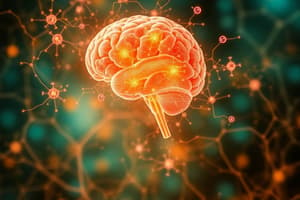Podcast
Questions and Answers
Which of the following best describes learning?
Which of the following best describes learning?
- A permanent change in behavior that results from experience (correct)
- A spontaneous reaction to stimuli
- Only observable changes in behavior
- A temporary change in behavior
Learning only occurs during the embryonic period.
Learning only occurs during the embryonic period.
False (B)
What is the role of the neural mechanisms in learning?
What is the role of the neural mechanisms in learning?
Neural mechanisms facilitate long-term changes in behavior.
Learning is an __________ process that ensures survival.
Learning is an __________ process that ensures survival.
Match the following terms with their definitions:
Match the following terms with their definitions:
What is a necessary condition for learning to be considered valid?
What is a necessary condition for learning to be considered valid?
Learning can occur even when behavior is not immediately observable.
Learning can occur even when behavior is not immediately observable.
Name one characteristic of the organism that could affect the learning process.
Name one characteristic of the organism that could affect the learning process.
What best defines instincts?
What best defines instincts?
Genes directly control behavior.
Genes directly control behavior.
What is the primary difference in activity between 'rover' and 'sitter' Drosophila larvae?
What is the primary difference in activity between 'rover' and 'sitter' Drosophila larvae?
The study of _____ involves how genetics and environment influence behavior.
The study of _____ involves how genetics and environment influence behavior.
What is the purpose of contextual fear conditioning?
What is the purpose of contextual fear conditioning?
The majority of memories stored in the brain are positive.
The majority of memories stored in the brain are positive.
In the case of Jim Twins, what commonalities were observed upon their reunion?
In the case of Jim Twins, what commonalities were observed upon their reunion?
What is the term used for the process where information is suppressed by the brain?
What is the term used for the process where information is suppressed by the brain?
Positive memory is characterized by the amplification of information that has significant consequences.
Positive memory is characterized by the amplification of information that has significant consequences.
What neurotransmitter is released during synaptic facilitation?
What neurotransmitter is released during synaptic facilitation?
The repeated stimulus, when paired with a pleasurable or irritating stimulus, results in _____.
The repeated stimulus, when paired with a pleasurable or irritating stimulus, results in _____.
Match the following types of memory with their definitions:
Match the following types of memory with their definitions:
Which of the following best describes sensitization?
Which of the following best describes sensitization?
Elicited behavior remains the same regardless of habituation or sensitization.
Elicited behavior remains the same regardless of habituation or sensitization.
In the context of visual habituation experiments, what was done to the participants to increase the threat's credibility?
In the context of visual habituation experiments, what was done to the participants to increase the threat's credibility?




